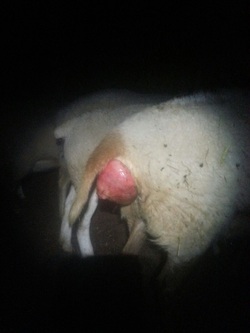|
24 hours later, 1118 is still doing fine with her uterus intact, safe inside the lambing pen with plenty of food and water. Caution before you read further: Graphic photographs below, not for weak stomachs.  This is what we found yesterday evening. I had read about it happening during birth, but did not know it could happen prematurely. After doing some research and speaking to the vet, we have learned that it is not terribly uncommon in the last month of pregancy - prevalence is about 15% according to one source. Fortunately, with proper care, ewes and lambs can survive the ordeal. The cause, according to my research, is having not enough room in the abdomen (increased intra-abdominal pressure) due to a variety of reasons including: * Excessive body condition - too much fat in the abdomen * Triplets * Distension of the rumen The ewe was in obvious distress. She was bawling and straining with the urge to push. The condition is very serious if not corrected. The sheep has difficulty urinating, and risks rupture of internal organs including the bladder and intestine. Additionally is the risk of infection. It felt like an eternity waiting for the vet to call back with his advice. In reality, it was less than one hour. He said, 'I could come out there and fix it and charge you $300, or you can fix it yourself. I think you can do it." First, we needed to lubricate the uterus and push it back in, with the ewe in a standing position. Next, he described a suturing technique similar to a purse string, creating a net to hold it in. One web site called it a Buhner suture. I learned later there are also plastic retention devices and harnesses available for this purpose, although many find the sutures most effective. Having no supplies on hand, we went to the next door neighbor and asked to borrow a cup of sugar and a bottle of rubbing alcohol for disinfectant. The shoestring from a spair pair of Connor's boots served as the suture. We washed it well and soaked it in alcohol. As if the ewe knew we were there to help her, and although she was obviously in pain, she willingly let us work on her without putting up much of a fuss. We poured the clean sugar water over the area to moisten it, then while one of us held her still, the other pushed carefully but forcefully to get her uterus back in place. We had to continue holding it in, otherwise she would push it back out. After a while she relaxed and it seemed to settle in to place. While I continued to hold her, farmer John, using a thin pointed knife to make small incisions and a wire to thread the string, put the sutures in place.  The final result, although not pretty, was secure. She was able to urinate and poo without any difficulty. The area was painted with betadine solution later to help prevent infection. For a couple of days, we will keep her in the lambing pen for her safety and to keep a close eye on her. Now, the tricky part will be identifying when she is ready to deliver so the sutures can be removed for birth.
0 Comments
Leave a Reply. |
AuthorMy name is Christy Franklin. Archives
February 2021
Categories |

 RSS Feed
RSS Feed
